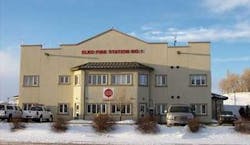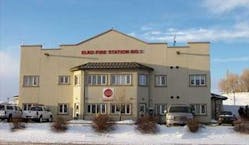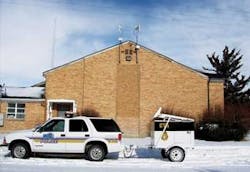A 19th Century Nevada city embraces 21st Century technology to connect geographically dispersed buildings.
by Pamela Valentine
The city of Elko, known as the hub of northeastern Nevada, is a mining and ranching town that grew out of the 1851 call (“Go West, young man”) to build the nation’s railroads and participate in the gold rush. Located at an elevation of 5,100 feet in the high desert, Elko was first settled in 1868 after the arrival of the Central Pacific Railroad, the portion of the first transcontinental railroad built from California to Utah. When the railroad crews moved on, Elko remained, serving as a ranch and mining freight and supply center.
The first Elko County Courthouse was built in 1869, and today, the Elko city government serves 36,000 residents and more than 600 businesses.
No city planner in the 1800s could have imagined that a town’s municipal buildings—city hall, courthouse, police department, fire department and others—would need to be in built in close proximity to each other for the practical purpose of running fiber or cable to connect thecity’s communications, computers anddata center services.
So, when Elko decided to network itsinformation and computer services, the cost to run fiber to city buildings—located quite a distance from each otheramong the region’s hilly 14.5-square-mile terrain—was cost-prohibitive.
A wireless mesh network offered Elko a perfect solution. Affordable, reliable and easy to install, the network now connects Elko’a data center (located at policedepartment headquarters) with city services that arelocated a distance away at the courthouse, and with the fire department (also located at a distance) to provide critical voice and data information to first responders.
A mesh network allows mesh nodes and access points to communicate with other nodes without being routed through a central switch point, eliminating centralized failure and providing self-healing and self-organization. The Elko network, designed and deployed by Nevada-based systems integrator JFG Systems (www.jfgsystems.com), enabled the city to implement a much more robust and error-proof communications system.
Network centralization
Deploying a wireless mesh network enables Elko toaffordably and reliably connect city buildings anddepartments to modernize its emergency communications, deliver instant software updates, and provideInternet access for city personnel.
“The wireless mesh network is the most resilient and affordable network computing solution for the city o fElko, because the cost of rewiring a building or trenching tolay miles of wires to connect sites is prohibitive,” comments Ron Baker, president of JFG Systems. “The city now securely connects its departments to improve emergency response and efficiency of city services with an easily reconfigurable network that can be deployed and expanded in phases.”
Before the deployment, the fire station was only able toreceive emergency dispatches via telephone from the dispatch center. This method wasted precious minutes, and all too often, inaccurate details were jotted down regarding the nature ofthe emergency, address, or directions to the location. The wireless network now enables the city to implement a much more robust and error-proof communications system.
“The Elko Fire Department refers to its new emergency communication system as ‘Rip-and-Run’,” says Brianne Clark, Elko’s information systems manager. “Now that the police department is networked to the firedepartment, firemen receive an instant printout of dispatch details. In addition, the dispatchers can send more timely reports via the network forinclusion in the fire department records, located in the central server at the police department.”
It used to take the city’s IT team at least one day a week to provide computer maintenance for the departments, since IT staffers had to drive to each location. Now, user access or passwords can be updated remotely in minutes.
The city has also reduced costs with more efficient IT maintenance, distributed Internet access, and improved software solutions. For instance, the network has made it possible for multiple city departments to access a central database, which has been an asset in unifying billing practices. Now, the landfill, animal shelter, fire department, and many other departments can access the same databases and files.
One such expansion made possible by the network is the city’s Geographical Information System that creates maps from tabular data. The network makes this project practical since it enables numerous city departments to access the maps, which are maintained in one location in a centralized database.
“In addition to improving our maintenance, data, and software development projects, we plan to continue to expand our network to include additional uses, such as IP security cameras for video surveillance,” says Clark. “We have also been able to use the solution to interface with legacy systems. The Elko airport is very far from the police department, and with its own contained security system. But now, if there is anincident at the airport, the system can alert us by connecting to our network through a wireless mesh node.”
Nodes on the hillside
“With Firetide, the wireless mesh network installation was quick, easy and reliable,” says Ron Baker of JFG Systems. “We’ve worked with the City of Elko for many years and recommend Firetide as the best wireless network system available tocreate a secure, reliable and fast centralized data and IT maintenance solution.”
Baker adds, “We easily overcame our biggest challenge to deliver network services to buildings that are separated by hills and miles apart—we put a mesh node on the top of each hill between the police station, court house, and fire department, and the network connection works perfectly.”
The city of Elko is an example of how mesh networks can address the needs of communities large and small to cost effectively and securely improve public safety and the efficiency of city services. Most importantly, the city now has a wireless infrastructure that will evolve seamlessly to support different wireless access technologies and more sophisticated municipal network applications as they become available.
Mesh ‘must-haves’ for city IT departments
All mesh networks are not the same, and choosing wisely ensures that investments made today will be protected against obsolescence—in other words, no “forklift upgrade” will be required to support future applications.
Cities and public safety agencies need a secure, high performance, standards-based wireless mesh infrastructure and access solution. The wireless mesh network should be capable of handling concurrent video, voice, and data applications to support video surveillance, Internet access, temporary networks, and more, wherever rapid deployment, mobility, and ease of installation are required.
When evaluating mesh networking technology, a city IT department should measure its choices against the following:
Network scalability—Ability to support up to 1,000 nodes per mesh for optimal expandability and management.
Modularity—A modular backhaul and access design, broadest range of radio band support and seamless indoor/outdoor operation to protect network investment.
Security—Multiple levels of security as compared to asingle-level security scheme.
Video performance—Evidence-grade real-time video streaming equal in quality to wired networks (30 frames per second).
Mobility—Roaming without interruption for real-time video and high-quality voice on moving vehicles with Wi-Fi client mobility across multiple Layer 3 domains.
Voice quality—Enabling VoIP without dead air or voice quality restricted by network performance.
The best wireless mesh networks are designed to provide maximum flexibility. Once an infrastructure is installed, more applications can be added to it, resulting in a more cost-effective deployment. The ability to amortize the cost of the mesh infrastructure over multiple applications offers any city a better way to manage OPEX (operating expenditure) and CAPEX (capital expenditure), and leverage available financial and human resources. —P.V.


